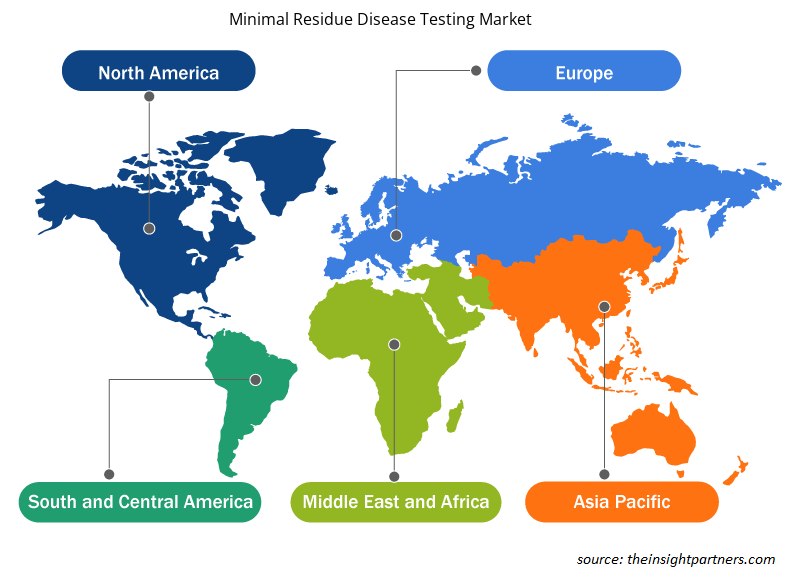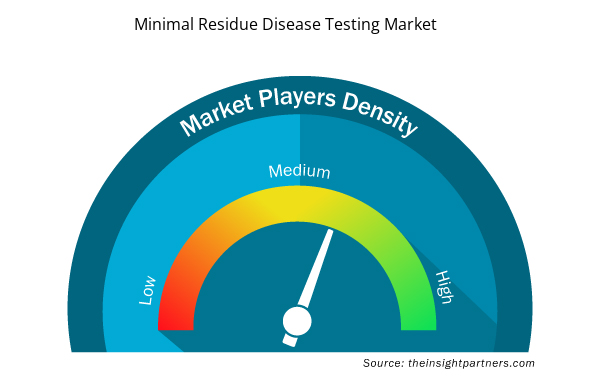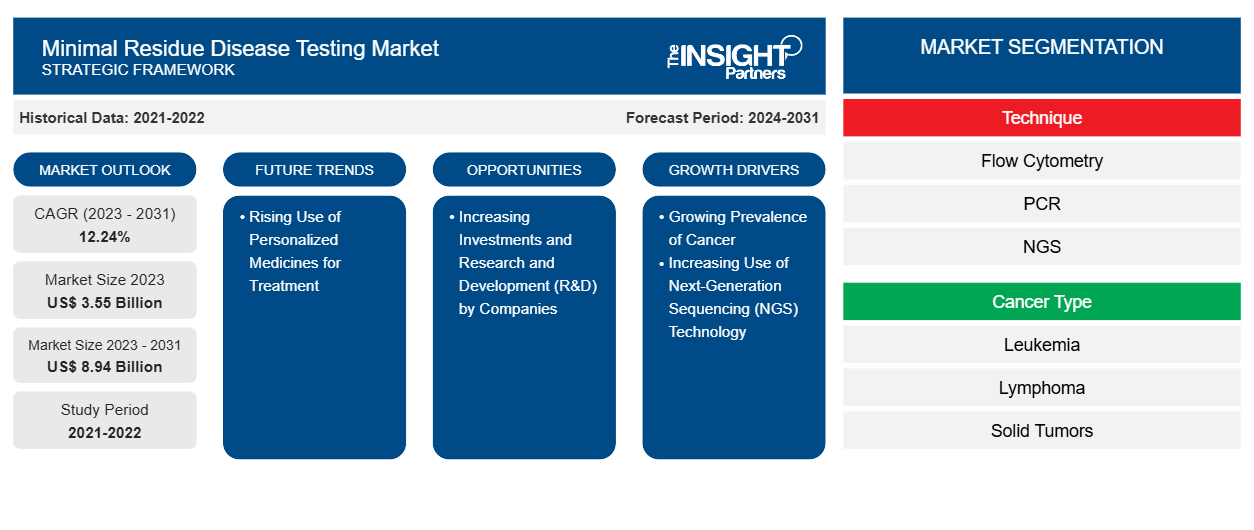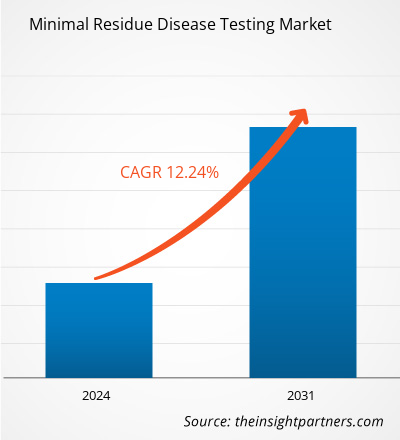微量残留疾患検査市場規模は、2023年の35億5,000万米ドルから2031年には89億4,000万米ドルに急増すると予測されており、市場は2023年から2031年の間に12.24%のCAGRを記録すると推定されています。
アナリストの視点:
このレポートには、現在の微量残留疾患検査市場の動向と予測期間中の予測可能な影響による成長見通しが含まれています。白血病、リンパ腫、固形腫瘍などのさまざまな癌の世界的罹患率の増加と、微量残留疾患検査製品およびサービスの需要。医療提供者と研究者は、治療反応の監視、再発の予測、治療介入のガイドにおける微量残留疾患評価の臨床的有用性を認識しています。微量残留疾患検査が進化を続け、癌管理における重要なツールとして浮上するにつれて、市場関係者は微量残留疾患検査市場の有利な機会を活用するために、革新、標準化、およびアクセシビリティに重点を置いています。
市場概要:
微小残存病変検査が健康保険プランに含まれ、この検査法が固形腫瘍の診断に応用されていることが、微小残存病変検査市場の成長要因となっています。また、世界中で消費者の意識が高まるにつれて、微小残存病変検査の需要も高まっています。医療提供者や研究者はこの傾向を認識しており、微小残存病変検査を臨床診療に組み込むことで患者の期待に応えようと努めています。微小残存病変検査市場の成長を牽引するその他の主な要因としては、がんの罹患率の上昇や次世代シーケンシング技術の利用増加などが挙げられます。
要件に合わせてレポートをカスタマイズする
このレポートの一部、国レベルの分析、Excelデータパックなど、あらゆるレポートを無料でカスタマイズできます。また、スタートアップや大学向けのお得なオファーや割引もご利用いただけます。
- このレポートの主要な市場動向を入手してください。この無料サンプルには、市場動向から見積もりや予測に至るまでのデータ分析が含まれます。
市場の推進要因:
がん罹患率の増加が市場の成長を促進
2020年のがん症例数は1,930万人に達し、がんによる死亡者数は996万人に達した。国際がん研究機関によると、がん症例数は2025年までに2,190万人、2030年までに2,460万人に達すると予想されている。米国臨床腫瘍学会による2021年2月の報告によると、米国では約235,760人の成人(男性119,100人、女性116,6600人)が肺がんと診断された。GLOBOCAN 2020のデータによると、インドは世界で記録された総新規がん症例の18.3%を占め、さらに子宮頸がんは全がん症例の9.4%を占めている。米国がん協会(ACS)によると、2021年に米国で約26,560人の新規胃がん症例が発見され、そのうち男性16,160人、女性10,400人であった。 2021年7月に全米乳がん財団が発表した統計によると、乳がん患者の約63%が局所乳がん、27%が局所乳がん、6%が遠隔(転移)疾患と診断されました。さらに、世界中で血液がんの罹患率が高まっているため、残留がん細胞を除去するためのより良い治療法と精度に対する需要が高まっています。米国がん協会が発表した統計によると、2022年1月に米国で推定34,920件の多発性骨髄腫の新規症例が診断されました。このようながん症例数の急増により、政府は新たながん予防プログラムを開始せざるを得なくなり、これが微量残留疾患検査市場の成長を促進すると予想されます。
セグメント分析:
最小残留疾患検査市場の分析は、技術、がんの種類、最終用途というセグメントを考慮して実施されました。
技術に基づいて、最小残留疾患検査市場は、フローサイトメトリー、PCR、NGS、その他に分類されます。フローサイトメトリーセグメントは、2023年に最大の市場シェアを占めました。PCRセグメントは、2023年から2031年の間に12.39%の最高のCAGRを記録すると予測されています。PCR法は、突然変異や染色体変化などの特徴的な遺伝子異常に基づいて癌細胞を検出できます。この技術では、検出可能性と計数性を高めるために、小さなDNAまたはRNAフラグメントの増幅が必然的に必要になります。これにより、癌細胞の数がわずかであるサンプル(血球や骨髄など)を使用しても、遺伝子異常を特定できます。PCRは感度が高いため、100,000個の正常細胞から1個の癌細胞を検出できます。検査結果の取得には5〜14日かかります。
がんの種類に基づいて、市場は白血病、リンパ腫、固形腫瘍、多発性骨髄腫に分けられます。固形腫瘍セグメントは、2023年に最大の微小残留疾患検査市場シェアを占めました。このセグメントの市場成長は、固形腫瘍の患者の評価に焦点を当てた進行中の研究調査に起因しています。非血液悪性腫瘍の検出にMRD検査を採用するための承認された推奨事項はありません。固形腫瘍治療後の残存分子疾患診断の予後バイオマーカーとして循環腫瘍DNA(ctDNA)を使用するアプローチは、臨床試験の設計とトランスレーショナルリサーチ調査に急速に取り入れられています。このアプローチは、標準的な臨床ケアでの使用に適しています。ctDNA検出技術は急速に進化していますが、これらの検出方法の感度が低いため、さまざまな臨床アプリケーションでのMRD検出における有用性が低下します。
エンドユーザーに基づいて、微量残留疾患検査市場は、病院、専門クリニック、診断研究所、その他に分かれています。病院セグメントは2022年に微量残留疾患検査市場で最大のシェアを占め、2023年から2031年にかけて12.79%という最高のCAGRを記録すると予想されています。病院は市場で大きなシェアを占めていますが、これは主に急性期ケアと患者管理における役割によるものです。病院の設備により意思決定能力が向上し、医師や医療専門家が患者を分析してより良い治療オプションを提供できるため、重篤な健康状態に苦しむ患者は入院が必要になることがよくあります。
地域分析:
微量残留疾患検査市場レポートの対象範囲には、北米、ヨーロッパ、アジア太平洋、中東およびアフリカ、南米および中米が含まれます。北米の市場は2023年に9億3,000万米ドルと評価され、2031年までに23億4,000万米ドルに達すると予測されています。2023年から2031年の間に12.12%のCAGRを記録すると予想されています。がん発生率の大幅な増加、最新技術の導入、確立されたプロテオミクス、ゲノミクス、腫瘍学研究インフラストラクチャにより、北米は微量残留疾患検査市場への主要な貢献者としての地位を固めています。
アジア太平洋地域の微量残留疾患検査市場は、12.68%という最も高いCAGRを記録すると予想されています。特にインドや中国などの国々を含むこの地域には、かなりの規模の製薬産業があります。2021年10月、Genetron Health(中国)とJiangsu Fosun(中国)は、中国でMRD検出検査の商業化を開始しました。両社は過去にも、中国の血液学に重点を置いた病院や診療所でSeq-MRDを推進してきました。この検査は、正確性、高スループット、費用対効果、一貫性、および迅速な処理時間を提供します。研究は、主要な市場プレーヤーが新しい検査を開発するための主要な焦点領域であると認識されています。研究への重点の高まりに加えて、治療後の癌患者のモニタリングに対する需要の高まりが、アジア太平洋地域の微量残留疾患検査市場の進展を牽引し続けています。さらに、医療インフラの改善と新興の製薬セクターにより、アジア太平洋地域は市場の大幅な成長と発展の重要な拠点となっています。
主要プレーヤー分析:
Adaptive Biotechnologies、Natera、Bio-Rad Laboratories、F-Hoffmann La Roche Ltd、Guardant Health、LabCorp、Sysmex Corporation、ARUP Laboratories、Invivoscribe, Inc.、NeoGenomics Laboratories, Inc.、および Mission Bio, Inc は、微量残留疾患検査市場レポートで紹介されている主要企業の一部です。
微小残留病変検査市場の地域別洞察
予測期間を通じて微小残留病検査市場に影響を与える地域的な傾向と要因は、Insight Partners のアナリストによって徹底的に説明されています。このセクションでは、北米、ヨーロッパ、アジア太平洋、中東、アフリカ、南米、中米にわたる微小残留病検査市場のセグメントと地域についても説明します。

- 微小残留病変検査市場の地域別データを入手
微小残留病変検査市場レポートの範囲
| レポート属性 | 詳細 |
|---|---|
| 2023年の市場規模 | 35億5千万米ドル |
| 2031年までの市場規模 | 89.4億米ドル |
| 世界のCAGR(2023年~2031年) | 12.24% |
| 履歴データ | 2021-2022 |
| 予測期間 | 2024-2031 |
| 対象セグメント | テクニック別
|
| 対象地域と国 | 北米
|
| 市場リーダーと主要企業プロフィール |
|
微小残留病変検査市場のプレーヤー密度:ビジネスダイナミクスへの影響を理解する
微量残留病変検査市場は、消費者の嗜好の変化、技術の進歩、製品の利点に対する認識の高まりなどの要因により、エンドユーザーの需要が高まり、急速に成長しています。需要が高まるにつれて、企業は提供を拡大し、消費者のニーズを満たすために革新し、新たなトレンドを活用し、市場の成長をさらに促進しています。
市場プレーヤー密度とは、特定の市場または業界内で活動している企業または会社の分布を指します。これは、特定の市場スペースに、その市場規模または総市場価値に対してどれだけの競合相手 (市場プレーヤー) が存在するかを示します。
微小残留病変検査市場で事業を展開している主要企業は次のとおりです。
- アダプティブバイオテクノロジー、
- ナテラ、
- バイオ・ラッド・ラボラトリーズ、
- F-ホフマン・ラ・ロシュ株式会社
- ガーダントヘルス、
- ラボコープ、
免責事項:上記の企業は、特定の順序でランク付けされていません。

- 微小残留病変検査市場のトップキープレーヤーの概要を入手
最近の動向:
微量残留疾患検査市場で事業を展開する企業は、合併や買収を主要な成長戦略として採用しています。各社のプレスリリースによると、最近の市場動向のいくつかを以下に示します。
- 2023 年 4 月、Quest Diagnostics は Haystack Oncology を買収し、高度な液体生検技術を取り入れて腫瘍学のポートフォリオを拡大しました。この買収により、Quest は高感度の診断機能を備えたツールやその他の製品を提供することで、個別化されたがん治療を改善できるようになりました。
- 2023 年 4 月、Integrated DNA Technologies は Archer FUSIONPlex Core Solid Tumor Panel を発売しました。この画期的な検査ソリューションは、より広範囲の単一ヌクレオチド変異 (SNV) とインデル (ヌクレオチドの挿入、欠失、または挿入と欠失) 機能をカバーし、がん研究を支援するために改良および改良されています。
- 2022年12月、Adaptive Biotechnologiesは、びまん性大細胞型B細胞リンパ腫(DLBCL)患者の循環腫瘍DNA(ctDNA)を使用して微小残存病変を評価するためのclonoSEQを発売しました。
- 2022 年 10 月、Adaptive Biotechnologies と Epic Systems Corporation は、clonoSEQ アッセイを Epic の包括的な電子医療記録 (EMR) システムに統合するために提携しました。clonoSEQ アッセイは、多発性骨髄腫 (MM)、慢性リンパ性白血病 (CLL)、B 細胞急性リンパ芽球性白血病 (ALL) に関連する微小残存病変を検出するために、米国食品医薬品局 (FDA) によって監視および承認されました。
- ロシュは2022年8月、特定のRNAとDNAの微量を正確に定量化するように設計された初のデジタルライトサイクラーシステムを発売しました。
- 2022 年 2 月、Personalis は Moores Cancer Center と提携し、進行性固形腫瘍および血液悪性腫瘍の患者に対する臨床診断検査のサポートを開始しました。この提携では、新たに導入された液体生検アッセイを使用して、高感度の微小残存病変およびがんの再発を検出するための研究を実施することに重点が置かれました。
- 過去2年間の分析、基準年、CAGRによる予測(7年間)
- PEST分析とSWOT分析
- 市場規模価値/数量 - 世界、地域、国
- 業界と競争環境
- Excel データセット



Report Coverage
Revenue forecast, Company Analysis, Industry landscape, Growth factors, and Trends

Segment Covered
This text is related
to segments covered.

Regional Scope
North America, Europe, Asia Pacific, Middle East & Africa, South & Central America

Country Scope
This text is related
to country scope.
よくある質問
The global minimal residual disease testing market, based on technique is divided into flow cytometry, PCR, NGS, and others. The flow cytometry segment held the largest market share in 2023, and the PCR segment is likely to register the highest CAGR of 12.39% during 2023–2031. Based on cancer type, the market is segmented into leukemia, lymphoma, solid tumors, and multiple myeloma. The solid tumors segment held the largest market share in 2023, and the same segment is estimated to grow at the fastest CAGR during 2023–2031. The lymphoma segment held the second largest market share in 2023. Based on end user, the market is segmented into hospitals, specialty clinics, diagnostic laboratories, and others. The hospitals segment held the largest minimal residue disease testing market share in 2022, and the same is anticipated to register the highest CAGR of 12.79% during 2023–2031.
The minimal residual disease testing market is expected to be valued at US$ 8.94 billion in 2031.
The minimal residual disease testing market was valued at US$ 3.55 billion in 2023.
The minimal residual disease testing market majorly consists of the players such as Adaptive Biotechnologies; Natera; Bio-Rad Laboratories; F-Hoffmann La Roche Ltd; Guardant Health; LabCorp; Sysmex Corporation; ARUP Laboratories; Invivoscribe, Inc.; NeoGenomics Laboratories, Inc.; and Mission Bio, Inc.
The factors driving the growth of the minimal residual disease testing market include the surging prevalence of cancer and the increasing use of next-generation sequencing technology.
Patients achieving complete hematologic remission after blood cancer treatment may foster residual cancer cells in the bone marrow or peripheral blood. These cells can result in relapse, as they persist at levels so low that they cannot be detected by conventional cytomorphology. Similar is the case with several other cancer conditions, including solid tumors and multiple myeloma. Minimal residual disease testing is employed to detect and quantify cancer cells existing in small numbers in a patient's body. This testing is performed by using sensitive technologies such as polymerase chain reaction (PCR), next-generation sequencing (NGS), and flow cytometry to identify measurable residual disease at the molecular level. Minimal residual disease testing is clinically important because it helps monitor response to treatment, predicts risk of relapse, guides personalized therapies, and serves as an endpoint in clinical trials.
Trends and growth analysis reports related to Life Sciences : READ MORE..
The List of Companies - Minimal Residual Disease Testing Market
- Adaptive Biotechnologies
- Natera
- Bio-Rad Laboratories
- F-Hoffmann La Roche Ltd
- Guardant Health
- LabCorp
- Sysmex Corporation
- ARUP Laboratories
- Invivoscribe, Inc.
- NeoGenomics Laboratories, Inc.
- Mission Bio, Inc.
The Insight Partners performs research in 4 major stages: Data Collection & Secondary Research, Primary Research, Data Analysis and Data Triangulation & Final Review.
- Data Collection and Secondary Research:
As a market research and consulting firm operating from a decade, we have published and advised several client across the globe. First step for any study will start with an assessment of currently available data and insights from existing reports. Further, historical and current market information is collected from Investor Presentations, Annual Reports, SEC Filings, etc., and other information related to company’s performance and market positioning are gathered from Paid Databases (Factiva, Hoovers, and Reuters) and various other publications available in public domain.
Several associations trade associates, technical forums, institutes, societies and organization are accessed to gain technical as well as market related insights through their publications such as research papers, blogs and press releases related to the studies are referred to get cues about the market. Further, white papers, journals, magazines, and other news articles published in last 3 years are scrutinized and analyzed to understand the current market trends.
- Primary Research:
The primarily interview analysis comprise of data obtained from industry participants interview and answers to survey questions gathered by in-house primary team.
For primary research, interviews are conducted with industry experts/CEOs/Marketing Managers/VPs/Subject Matter Experts from both demand and supply side to get a 360-degree view of the market. The primary team conducts several interviews based on the complexity of the markets to understand the various market trends and dynamics which makes research more credible and precise.
A typical research interview fulfils the following functions:
- Provides first-hand information on the market size, market trends, growth trends, competitive landscape, and outlook
- Validates and strengthens in-house secondary research findings
- Develops the analysis team’s expertise and market understanding
Primary research involves email interactions and telephone interviews for each market, category, segment, and sub-segment across geographies. The participants who typically take part in such a process include, but are not limited to:
- Industry participants: VPs, business development managers, market intelligence managers and national sales managers
- Outside experts: Valuation experts, research analysts and key opinion leaders specializing in the electronics and semiconductor industry.
Below is the breakup of our primary respondents by company, designation, and region:

Once we receive the confirmation from primary research sources or primary respondents, we finalize the base year market estimation and forecast the data as per the macroeconomic and microeconomic factors assessed during data collection.
- Data Analysis:
Once data is validated through both secondary as well as primary respondents, we finalize the market estimations by hypothesis formulation and factor analysis at regional and country level.
- Macro-Economic Factor Analysis:
We analyse macroeconomic indicators such the gross domestic product (GDP), increase in the demand for goods and services across industries, technological advancement, regional economic growth, governmental policies, the influence of COVID-19, PEST analysis, and other aspects. This analysis aids in setting benchmarks for various nations/regions and approximating market splits. Additionally, the general trend of the aforementioned components aid in determining the market's development possibilities.
- Country Level Data:
Various factors that are especially aligned to the country are taken into account to determine the market size for a certain area and country, including the presence of vendors, such as headquarters and offices, the country's GDP, demand patterns, and industry growth. To comprehend the market dynamics for the nation, a number of growth variables, inhibitors, application areas, and current market trends are researched. The aforementioned elements aid in determining the country's overall market's growth potential.
- Company Profile:
The “Table of Contents” is formulated by listing and analyzing more than 25 - 30 companies operating in the market ecosystem across geographies. However, we profile only 10 companies as a standard practice in our syndicate reports. These 10 companies comprise leading, emerging, and regional players. Nonetheless, our analysis is not restricted to the 10 listed companies, we also analyze other companies present in the market to develop a holistic view and understand the prevailing trends. The “Company Profiles” section in the report covers key facts, business description, products & services, financial information, SWOT analysis, and key developments. The financial information presented is extracted from the annual reports and official documents of the publicly listed companies. Upon collecting the information for the sections of respective companies, we verify them via various primary sources and then compile the data in respective company profiles. The company level information helps us in deriving the base number as well as in forecasting the market size.
- Developing Base Number:
Aggregation of sales statistics (2020-2022) and macro-economic factor, and other secondary and primary research insights are utilized to arrive at base number and related market shares for 2022. The data gaps are identified in this step and relevant market data is analyzed, collected from paid primary interviews or databases. On finalizing the base year market size, forecasts are developed on the basis of macro-economic, industry and market growth factors and company level analysis.
- Data Triangulation and Final Review:
The market findings and base year market size calculations are validated from supply as well as demand side. Demand side validations are based on macro-economic factor analysis and benchmarks for respective regions and countries. In case of supply side validations, revenues of major companies are estimated (in case not available) based on industry benchmark, approximate number of employees, product portfolio, and primary interviews revenues are gathered. Further revenue from target product/service segment is assessed to avoid overshooting of market statistics. In case of heavy deviations between supply and demand side values, all thes steps are repeated to achieve synchronization.
We follow an iterative model, wherein we share our research findings with Subject Matter Experts (SME’s) and Key Opinion Leaders (KOLs) until consensus view of the market is not formulated – this model negates any drastic deviation in the opinions of experts. Only validated and universally acceptable research findings are quoted in our reports.
We have important check points that we use to validate our research findings – which we call – data triangulation, where we validate the information, we generate from secondary sources with primary interviews and then we re-validate with our internal data bases and Subject matter experts. This comprehensive model enables us to deliver high quality, reliable data in shortest possible time.


 このレポートの無料サンプルを入手する
このレポートの無料サンプルを入手する